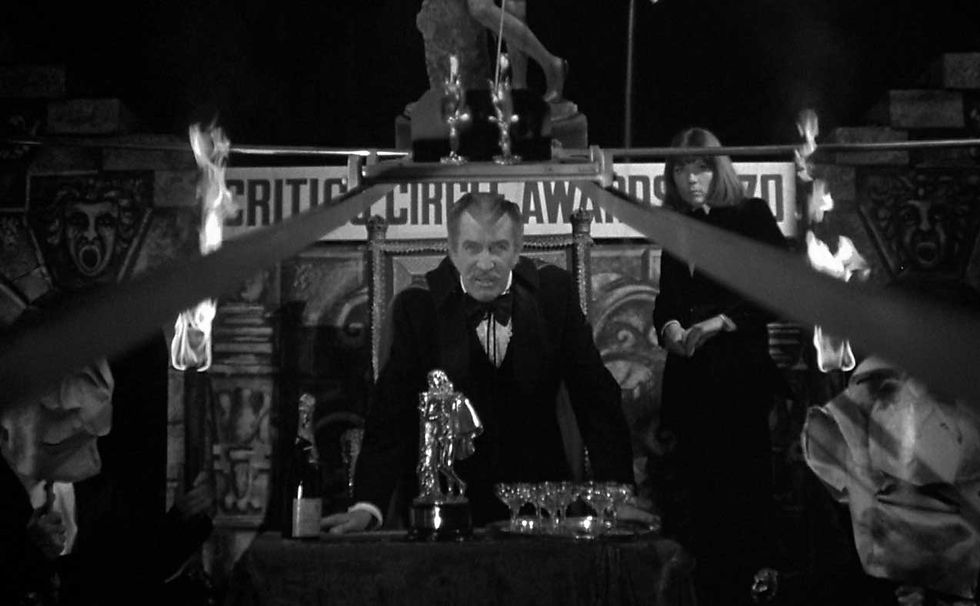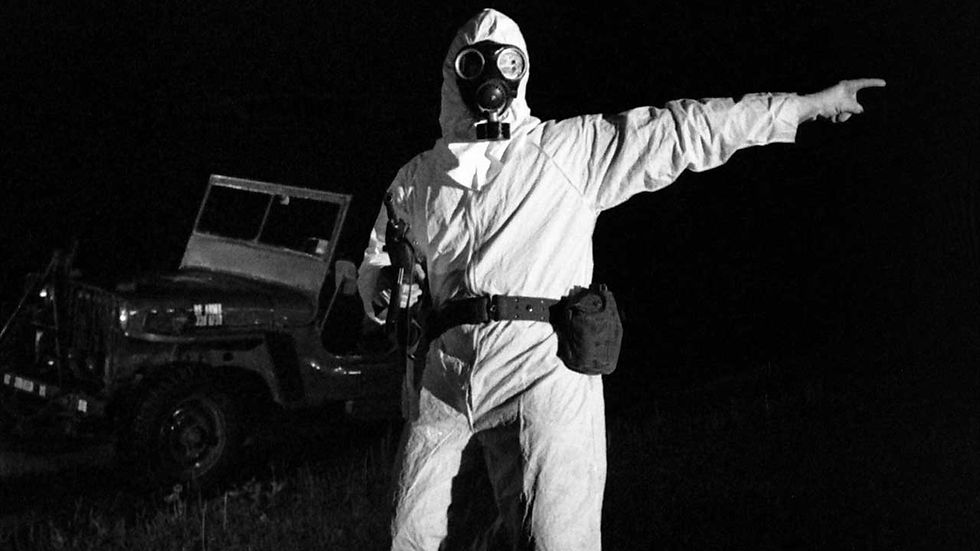FIVE FILMS FROM...1973
- RJ BLAND & DAVID STEPHENS
- Feb 23, 2019
- 7 min read


The Legend of Hell House
(Directed by John Hough)
This inventive movie is sometimes written off as the poor cousin to Robert Wise’s “The Haunting” (1963), which is understandable if entirely unfair. Both films are based on books around ghost-prone buildings being investigated by a small group of experts. But “Hell House” has its own unique wrinkle on hauntings and a very different direction. It’s based on a book written by the great genre author Richard Matheson, who also wrote the screenplay to ensure the ideas copied across. (NB: That said, the sexual elements were still toned down for the movie). Whereas the classic Wise film contains a fair bit of ambiguity with its scares, the supernatural element is certainly in no doubt here. But what does elevate “Hell House” to superior Haunted House fare, is the combination of modern-day investigative theories around life-after-death (residual electromagnetic energy, and the phenomena of “surviving personalities”), along with a superior cast and a slightly deranged but engaging plot. A renowned Physicist leads two mediums (and his wife) into the gothic grounds of Belasco House, which is supposedly haunted by a multitude of spirits, in order to find proof of life after death.
Given that the duration of their investigation eventually consists of violent poltergeist activity, spiritual possession, demonic cats, and entombed corpses… you would have thought that they would tick a few boxes and skedaddle post-haste. But instead the narrative plays out in a most satisfying way, with some extremely solid performances from the likes of Roddy McDowall (in one of his best non-“Planet of the Apes” roles) and Gayle Hunnicutt (as the tormented and repressed wife). It balances the scientific theories nicely with the overt spiritualism, to give an undercurrent of believability to the mist-strewn mansion and its inhabitants. It even manages to handle a major twist to the plot that sounds preposterous when spoken aloud (it centres on the identity and appearance of the “antagonist”), that comes across as creepy and fitting when it’s actually played out. A firm favourite to those that have caught it on late-night showings during the 80s and later, this is a quintessential “Haunting” film that should be sought out. Director Hough would later go on the direct the Disney horror, “The Watcher in the Woods”.

Theatre of Blood
(Directed by Eugenio Martín as Douglas Hickox)
As we’ve seen in earlier blogs, the early 70s were a Golden Age for classic Vincent Price performances, and this contains one of his hammiest and most enjoyable. The movie was reputedly another clear favourite from the iconic actor, and also that of its leading lady Diana Rigg in a rare villainous role (before GOT obviously). There are clear parallels between this movie and the “Dr Phibes” films, and TOB is even campier and intentionally OTT in some respects. The whole thing is a lovingly crafted send-up of the great British traditions of Shakespeare, “Luvvy” pretentiousness, actors’ egos, and self-important critics. Price literally takes centre stage as the hammy actor Edward Kendal Sheridan Lionheart, with Rigg wearing a variety of unconvincing disguises as his just-as-loopy daughter Edwina. After failing to earn a critics award, Lionheart fakes his death and starts to despatch his naysayers in style of the bard’s best slaughter-pieces.
So we see one character “fed his own babies” in the style of “Titus Andronicus” (actually his poodles in a pie), another give his “pound of flesh” a la’ “The Merchant of Venice” (his heart is cut out), and so on. Of course it all amounts to Price giving his finest eye-rolling best as he mangles lines of Shakespeare to great effect, coupled with great moments of Grand Guignol subjected on a classic English cast (Jack Hawkins, Ian Hendry, Eric Sykes, Arthur Lowe, etc). It also satirises some of the 70s tropes such as hospital soap operas and cookery shows. Totally, totally ludicrous, it’s all the more enjoyable for being so daft in the extreme, with a cheerfully gruesome (and painfully) slow decapitation being a particular highlight. The film is also known as being responsible for introducing Price to this third wife (Coral Browne), who he electrocutes during the story. The film is so fondly regarded that it actually spawned a stage adaptation that played the UK’s National Theatre in 2005. Also noteworthy is the fact that one of the director’s sons is Anthony Hickox, who made the “Waxwork” films and “Hellraiser III: Hell on Earth”, amongst many other genre offerings.

The Creeping Flesh
(Directed by Freddie Francis)
Despite the fact that TCF is one of the 70s films that starred genre actors Peter Cushing and Christopher Lee on a double-billing, this scary little number appears to be perennially overlooked in film listings. But this Tigon production actually contains some intriguing ideas neatly wrapped-up in a gothic narrative. Whilst the main draw is the somewhat troubling idea of an enormous ghoul being resurrected by the mere exposure to water, the narrative also plays around with the nature of evil itself, and that it could be treated and confined like a disease. It also has Cushing and Lee both playing mad scientists of a sort, and warring brothers to boot! Like 1972’s “Horror Express”, one of the leads finds a fossilised skeleton. But this time it’s Cushing’s Professor Hildern that finds the bony entity in 1894 during an expedition to New Guinea. He’s alarmed to find that water causes flesh to reconstitute on one of its fingers, which leads to all manner of nasty complications.
Leaving aside some of the more ponderous moments and some pacing issues (it takes a hell of a long time for that half-expected rainstorm to develop); this is something of an underrated piece. For a start there’s some great verbal sparring between the two leads, and the plot tries to be something more significant than just a twist on the old monster-on-the-loose scenario with its moral and scientific assumptions. Classic Hammer director Francis (who replaced Don Sharp at the last moment) makes it feel like an old-school horror in tone. There’s also a tremendous build-up to the resurrection of the creature, with its hand being mistakenly dunked in a trough and the rain coming down. The thing admittedly looks better when it skulks around like a latter-day Grim Reaper towards the end, as oppose to when you get a good-ish look at it, but the tension is there. There are even a neat couple of twists in the tale before the credits roll. Maybe it’s not a classic offering from the two legends, but it still comes close and is a (literal) creepy treat.

Don't be Afraid of the Dark
(Directed by John Newland)
The 2010 version of 'Don't Be Afraid of the Dark' is ok I guess. Those looking for an atmospheric chiller could do a lot worse. But one of the reasons it feels a little underwhelming is that it didn't capture the nightmarish terror of the 70's original. Yes, that's right! Before Katie Holmes and Guy Pearce fannied around in that old house, there was an older and more scarier version of the movie out there! Although you probably knew that already...
As mentioned in our 71' and 72' lists, TV horror movies were the breeding ground for some really great ideas in the seventies and some of them were great nightmare fuel for unsuspecting children. One of those was Guillermo Del Toro (who would go on to do the remake) for whom this was a personal fave.
"It was something close to my heart for a very long time ... We thought the movie was the most terrifying on Earth", he is quoted as saying. High praise indeed. Sally (Kim Darby) inherits a mansion from her grandmother and shortly after moving in with her husband, discovers a bricked-up fireplace in the basement. The estate's handyman informs her that her grandmother instructed him to do it before she passed away. I mean, that's gotta get you a little bit freaked out right? Of course, Sally tries to prise it open and it isn't long before weird stuff begins to start happening. She can hear strange whispers, unseen assasilants tug at her dress when she finally sees what is responsible for all the shenanigans...well, nervousness turns to terror.
DBAOTD is a lean, swiftly paced movie that's filled with tension and suspense and which also shows that small-screen horror can be incredibly effective. Like most TV movies, the limited budget shows at times and it isn't a film that's aged particularly well but there are some really really creepy scenes that will linger in the memory for anyone that's seen this. The practical effects just add to the scenes of menace too. It's a classic 'things go bump in the night' movie that is definitely worth revisiting.

The Crazies
(Directed by George A. Romero)
Yep, another film that's been remade (although that is probably true for half of our picks every week). The remake is actually pretty decent but it's worth remembering that the original is a damn fine movie and rightfully considered a cult classic. It's easy to overlook it as Romero is predominantly known for his genre defining work on his Night of the Living Dead series. However between Night of and Dawn of, he made The Crazies. A film that mixes zombie fun with 70's paranoia of the military and the government.
A military plane carrying an untested bioweapon crash-lands in the the Pennsylvanian hills, infecting the water supply with a virus called "Trixie," which causes victims to either die or become homicidally insane. "Trixie" is highly contagious, with anyone drinking from the reservoir becoming affected. Mayhem ensues and Washington sends in a couple of experts to get things under control. When this fails, they turn to Plan B - which involves a lot of guns and violence...
The Crazies failed at the box office but like a fine wine - or an annoying teenager, it matured with age and found a new audience and appreciation in the years that followed. It's an action-packed - and pretty brutal - experience. In the opening scene, an infected father of two murders his wife and sets his house on fire, with his two young children still inside. It's a movie where friends kill friends and parents kill children. Some pretty uncomfortable concepts right there. The film also explores the idea of how those in authority act (and react) in terms of crisis. We'd all like to think (and hope) that those in a position of power are a) capable and b) have our best interests at heart. However, that's quite often not the case.
Also, this is a Romero film - so don't expect a happy ending.
















































Comments